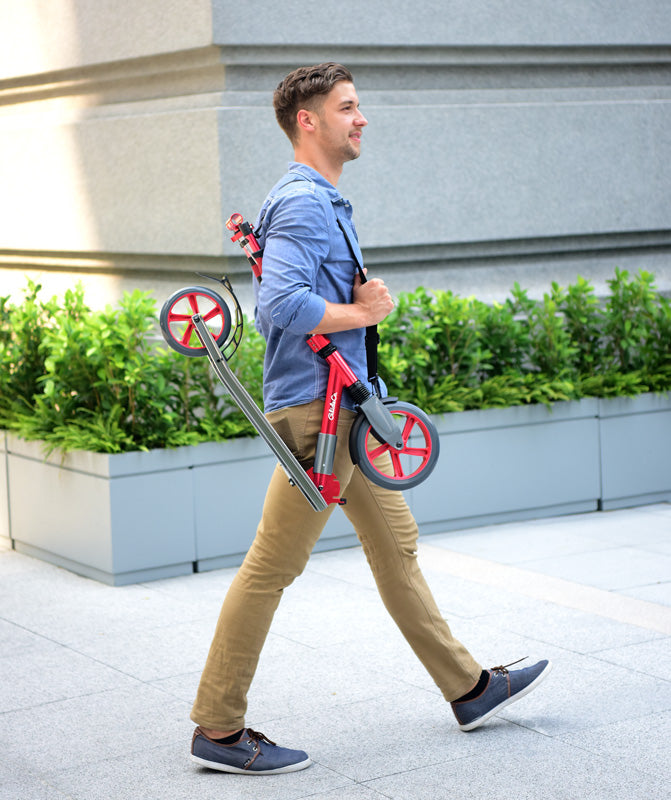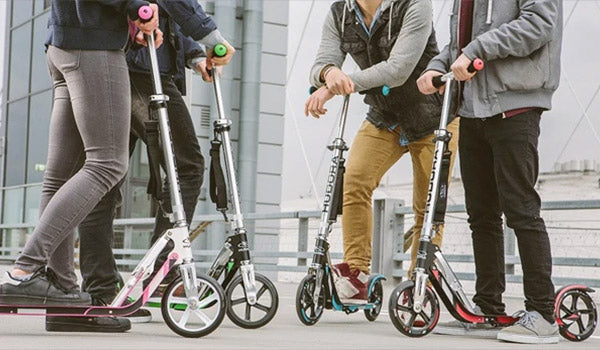
How to choose a kick scooter for adults
Decks & Scooters is a specialist in kick scooters. We sell directly to customers, as well as distribute kick scooters to bicycle and sports stores. We have been asked very often about how to choose a kick scooter. We have gathered all the questions and answers and put them into this detailed article to help you answer the most common questions.
This article attempts to answer questions like:
- How should I choose a kick scooter?
- Which kick scooter is best for me?
- Should I get one with or without suspension (shock absorbers)?
- Are large wheels or small wheels better?
We will examine the technical aspects of kick scooters that have an impact on your purchase considerations. This article is written in the context or riding an adult kick scooter in Singapore, but will apply to most urban environments around the world.
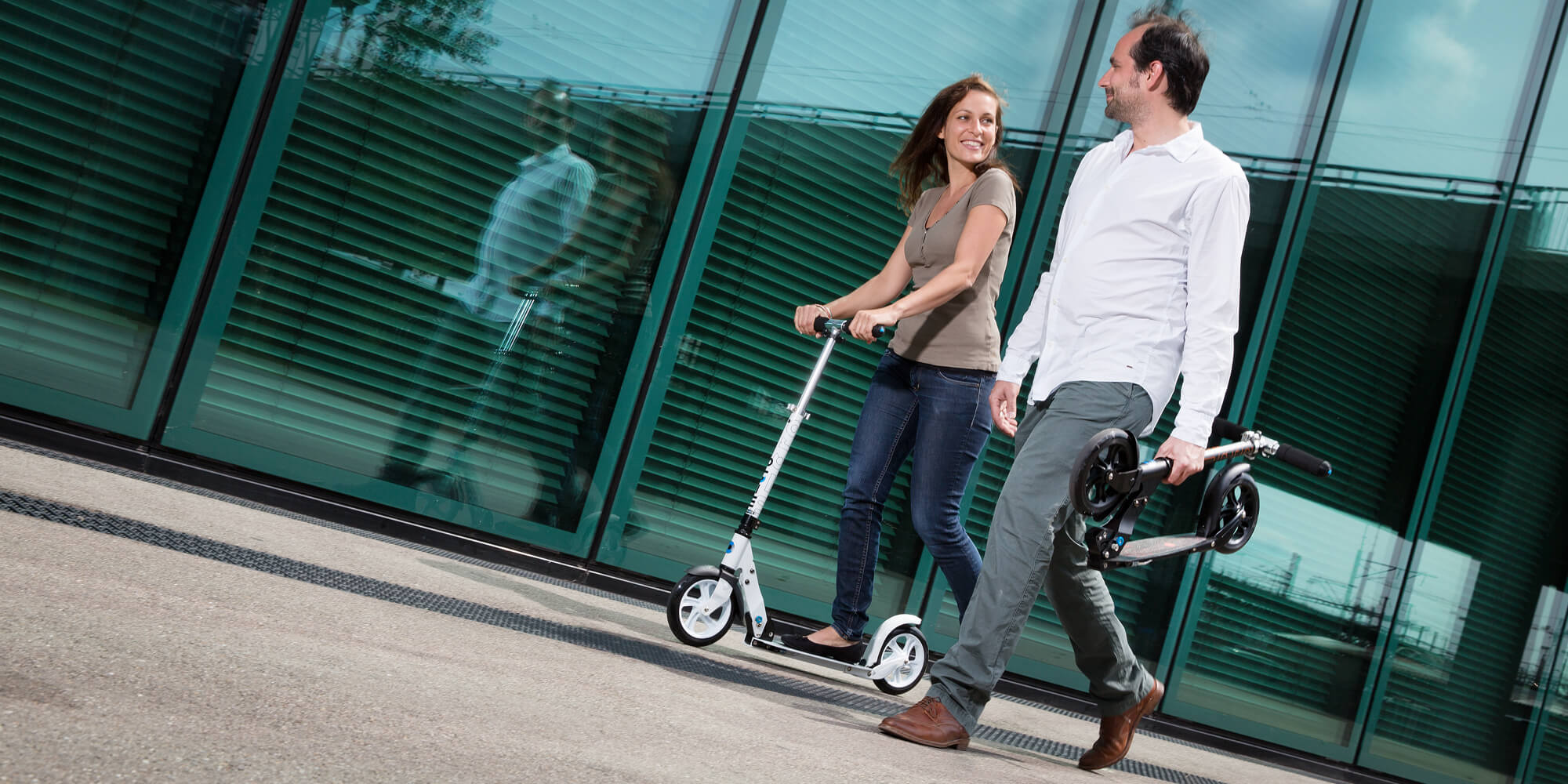
Above: Swiss maker Micro's most iconic commuting scooter, the Micro Black and Micro White. Image: Micro.ms
OVERVIEW
The purpose of a kick scooter
Most adults buy a kick scooter for one or both of these main purposes:
- transportation or daily commute
- Weekend sport or leisure
Purchase considerations
Based on the two main purposes above, we have distilled the many purchase considerations down to three main ones:
- Practicality / convenience
how easy or hard it is to bring the scooter around and use it on a daily basis - Performance
how fast or far the scooter can glide with each push - Comfort / Ride quality
how comfortable it is to push and how much vibration the scooter transmits from the ground
Technical Features
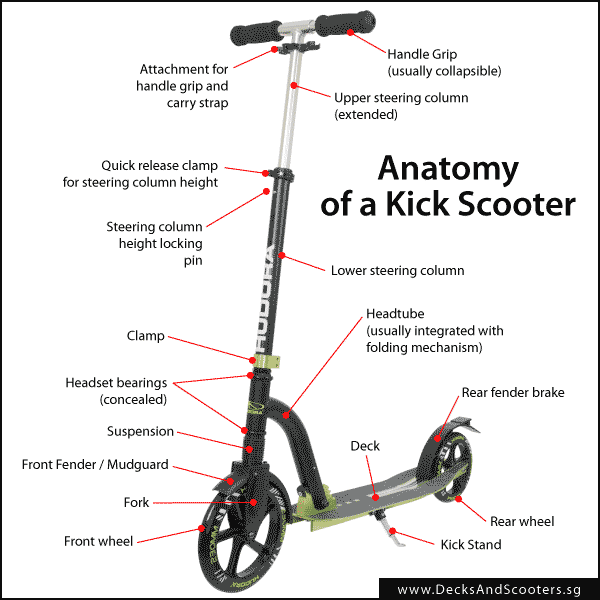
The three main purchase considerations above are affected directly by the technical features of the kick scooter. The major features of adult kick scooters are:
- Wheel size
- Bearing quality and grade
- Deck size
- Deck height (distance from the ground)
- Folding mechanism
- Suspension (shock absorbers)
- Bicycle-style handbrakes (or the lack of it)
- Other attachments (kick stand, carry strap)
- Overall build quality
Knowing the advantages and disadvantages of the parameters in these features will help you decide which features to choose in the context of the daily commute versus a cruise in the park.
Here is the detailed explanation of how the major technical features affect the performance, comfort and practicality of a kick scooter.
Wheel Size
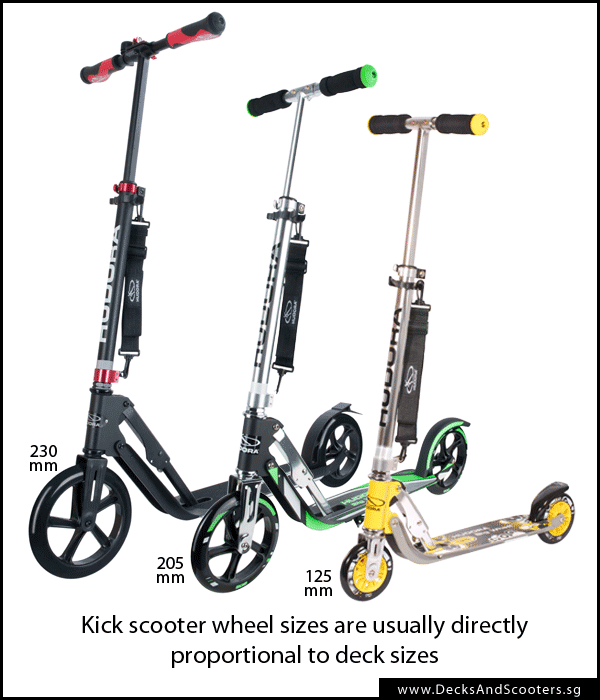
The wheel size is the most obvious distinguishing feature on a kick scooter.
Most kick scooters have wheels made of plastic core embedded into polyyurethane (PU) thread. PU is a very effective material for wheels used on urban surfaces. It has been used in skateboard, inline-skate and roller-skate (quad) wheels for decades. It is light, wear-resistant, has a reasonable amount of grip (when dry), and rebound (the abililty to return to its original shape after momentary compression due to weight or pressure).
Large wheels
(180, 200 or 230mm diameter)
Advantages
- Longer glide distance per push (Better rolling efficiency)
- Better shock absorption
- More chances of rolling safely over objects on the ground (like twigs, pebbles) or cracks
- Usually matched with larger deck for comfort
Disadvantages
- Heavier to carry around (typically 4 to 6.5kg)
- Physically larger and more cumbersom. A possible problem in crowded public transport.
- Takes more effort to speed up and slow down (lower rate of acceleration)
- Less agile with a larger turning radius
Conclusion
Larger wheels are good for performance (faster) and comfort (less vibrations) but make the scooter less convenient to lug around.
Small wheels
(100, 120, 125 or 145mm diameter)
Advantages
- Lightweight (usually below 4kg)
- Easier to speed up and slow down
- More agile and nimble with a smaller turning radiu
Disadvantages
- Lower rolling efficiency: shorter glide distance with each push
- Transmits more vibration from the ground
- Relatively higher chance of wheels catching on random objects or cracks
Conclusion
Smaller wheels are good for convenience (portable) but score lower on performance (slower) and comfort (more vibrations).
Above: a carry strap like the one found on the Glideco Cruiser helps make a scooter portable.
Bearing Quality and Rating
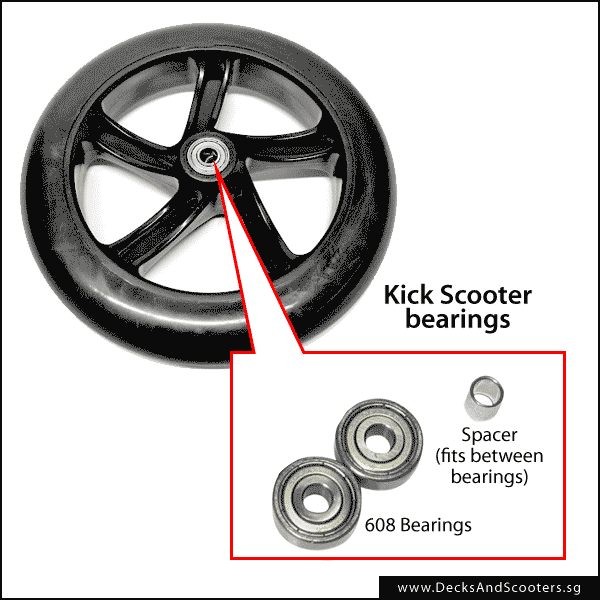
Kick scooter wheels use the same type of bearings that have been used in skateboards and inline skate wheels for decades: the 608 bearing. Each kick scooter wheel has two bearings, they are mounted in the centre of each wheel (called the wheel-hub).
This one is easy. Generally, the higher the bearing rating, the higher the performance. There is no downside to a higher bearing rating.
But what is bearing rating? The rating recognised in engineering is the ABEC standard, short for Annular Bearing Engineering Committee, named after the body that established the standard.
The ABEC ratings are (from lowest precision to highest precision) 1, 3, 5, 7 and 9. Most kick scooters in the market use bearings rated ABEC 5 to 7.
The higher the precision, the lower the rolling resistance/friction. Lower friction translates into a longer glide distance for every push. This can be readily experienced when riding a scooter, and is often what makes you feel or judge if a scooter is 'fast' or 'slow'.
However, not all bearings are created equal. In practice, the quality of the bearing has a more perceptible impact than the rating of the bearing. In other words, a well made ABEC 5 bearing will spin better than a poorly made ABEC 7. In general, higher priced, more well-known kick scooter brands tend to use higher quality bearings (rating aside).
Fortunately, bearings can be easily replaced. They can be found in skateboard stores or inline-skate stores.
Conclusion
The higher rating, the better, Bearings in well known brands tend to be of higher quality than bearings from unbranded kick scooters.
Deck/Foot-board Length
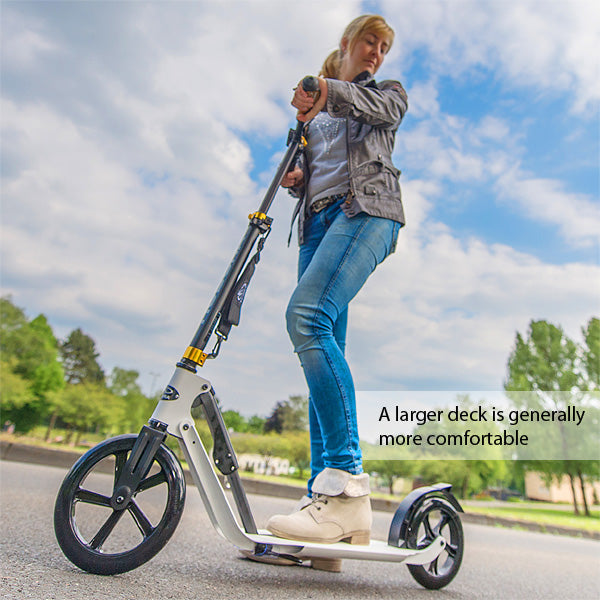
The deck of the scooter is where the rider stands. Some people call it the foot-board. Before talking about the deck size you have to first understand the correct riding posture.
The correct riding posture is described as follows:
Stand with your master leg (balance leg) on the deck. The foot should be at the centre of the deck width-wise, and placed as forward on the deck as it allows. The tip of your shoe should be very close to, or touching the front end of the deck. The foot of the pushing leg (action leg), when not pushing, should be tiptoed at the heel of the master foot.
Larger Deck Size
Advantages
- Easier to step on and off the scooter
- Generally more comfortable as you can shift your weight, or change foot position more easily as you ride
- A larger deck results in a longer wheel base. Longer wheel bases are more efficient for long rides because it is easier for the scooter to maintain a straight line as it rolls. Each time you push the scooter, it 'wiggles' a little bit, resulting in a slighly serpentine line of movement. The less this happens, the more efficient the scooter is.
Disadvantages
- The scooter tends to be larger and heavier
- It takes more effort to speed up and slow down a larger and heavier scooter
Smaller Deck Size: Generally the opposite of the above.
CONCLUSION
For portability, choose a small deck size. For comfort, choose a large deck size.
Deck Height
Deck height refers to the distance between the surface of the deck (i.e. the bottom of your feet) to the ground.
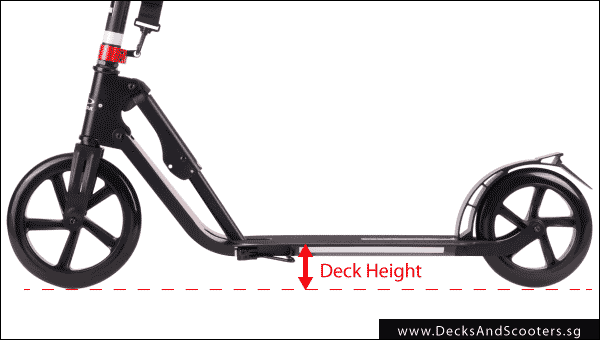
It is one of the biggest, but least known factors influencing the comfort of a kick scooter.
Generally, the lower the deck, the more comfortable it will be to push the kick scooter. With a low deck, you don't have to bend the knee of the leg that is standing on the deck much to be able to push the other feet against the ground. A lower deck on a kick scooter often makes you prefer it because it is more comfortable to push.
Kick scooter makers have adopted the "deep drop" deck design of top-mounted skateboards to lower the deck.
Below: a longboard with a "deep drop" shape to lower the deck height

Because it is more expensive, and technically difficult to manufacture a deep drop deck, low decks tend to be found only on high-end kick scooters.
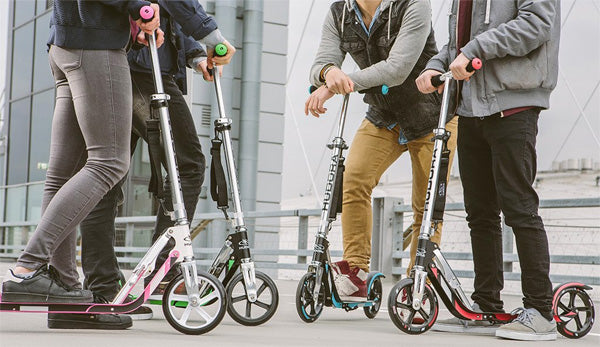
Low Deck Height
Advantages
- Makes the kick scooter very comfortable to push, allowing you to ride in a very relaxed manner
- Increased stability with lower centre of gravity
Disadvantages
- Higher chance of the bottom of the kick scooter scraping raised ground like a hump
Conclusion
Choose a kick scooter with as low a deck height as possible.
Suspension (Shock absorbers)

Above: front suspension (ribbed section) in a kick scooter. Below: a typical kick scooter rear suspension system.
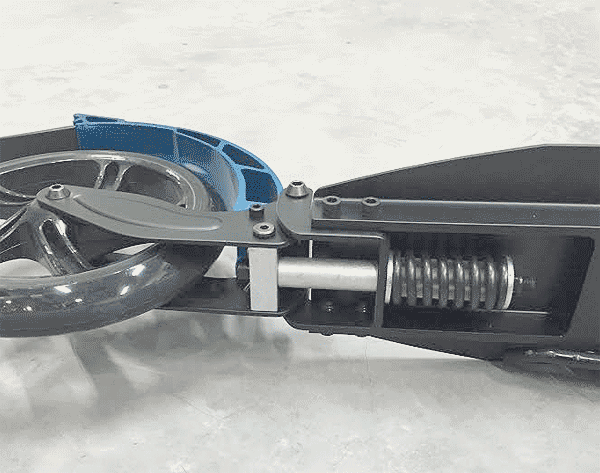
Suspension refers to a shock absorption mechanism. In kick scooters, these are usually spring-based. Suspension may be installed only at the front of the kick scooter, or at both front AND rear.
As of 2016, most kick scooters models in the market from major international brands DO NOT feature suspension. However, suspension is a popular feature in low priced OEM or on kick scooters found in sports sections of department stores. This is probably because customers feel they get more value for money with scooters with suspension.
Between Europe and North America, more European kick scooter brands feature models with suspension. This may have to do with the higher likelihood of European cities having very old historical quarters that may have unpredictable sidewalk surfaces.
The main purpose of suspension is to absorb the micro-shocks that come from rolling over rough surfaces at speed.
Advantages
- More comfortable on rough or uneven surfaces
Disadvantages
- Suspension add lots of weight to a kick scooter (total scooter weight is typically 4.5 to 6kg)
- More moving parts means more squeaks and rattle during riding.
- More moving parts means higher chances of parts wearing out or breaking
- Scooters with tend to be less responsive because some of the energy from your push is lost to the up-down oscillation of the scooter body as it rolls.
Conclusion
Suspension is good for comfort, but performance and convenience suffers (the scooter is bigger and heavier). So it is a personal choice.
If you always ride the same route and you know for a fact it is rough, go for the suspension. Inline-skaters and skateboarders have been riding tiny wheels on all kinds of rough surfaces for decades without complaining, so most people are happy without suspension.
If suspension is important to you, there are also lighter weight alternatives to spring based suspension:
- skateboard style cambered wood decks instead of the standard aluminum decks (Swiss maker Micro)
- air filled pneumatic wheels (American maker Fuzion, Swiss maker Micro, German maker Hudora)
- solid synthetic tyres (American maker GoPed)
- special wheel designs with shock absorbing mechanisms in wheel hubs (Swiss maker Micro)
Folding Mechanism
With the exception of all-terrain scooters (for off-road riding) and freestyle 'pro-scooters' (for stunts and tricks), most kick scooters in the market can be folded down.
The vast majority of kick scooter folding mechanisms involves a hinge between the deck and the steering column that allow them to be folded together.
The most common folding mechanism is probably the three-action folding mechanism (see image below). It consists of a simple spring-loaded locking pin which can be shifted between two positions which fold or unfold the scooter.

To fold or unfold the kick scooter, the user (1)uncompresses the joint with the quick-release clamp, (2)lift the locking pin up from the notch and shift it into the other notch, and then (3)re-compresses the clamp.
Most of the kick scooters in existence use a variation of this mechanism. However, some brands have made the folding easier, often by removing steps (1) and (3), resulting in a single-action mechanism.
Some examples are
- the Hudora "One-Step-Easy" system (Patented)
- the Hudora "Heavy Duty" folding systen (Patent pending)
- the Razor A5 Lux Patented folding mechanism
- the GlideCo Single Key single-action system
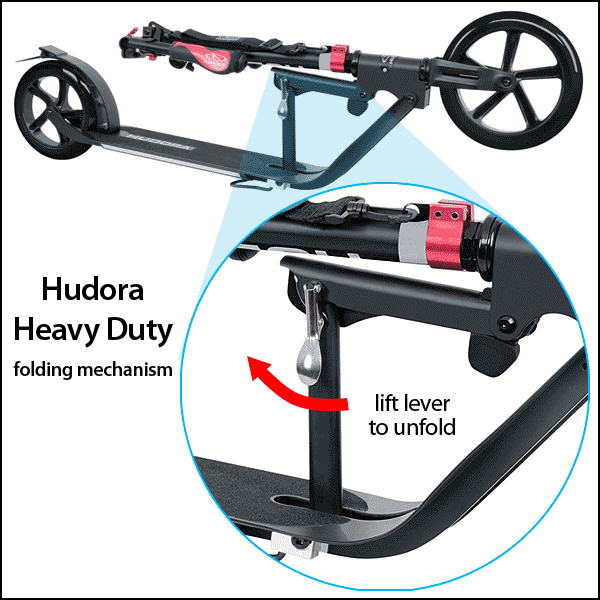
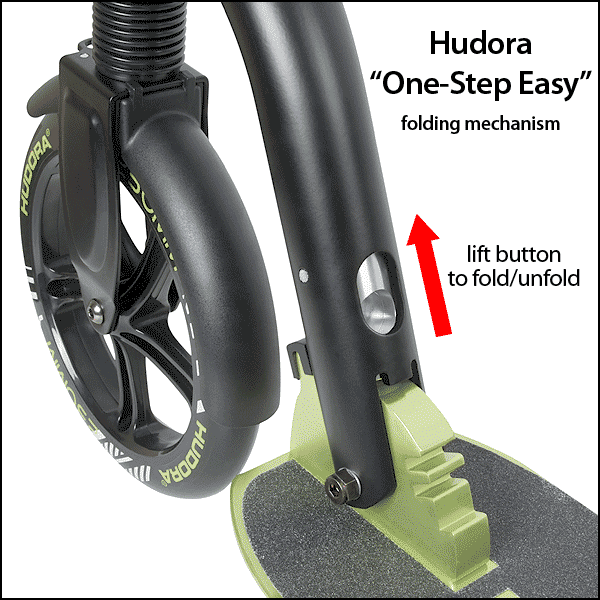
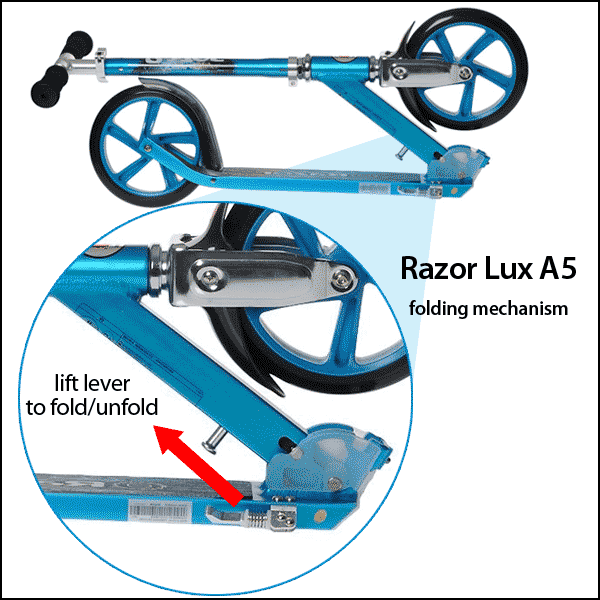
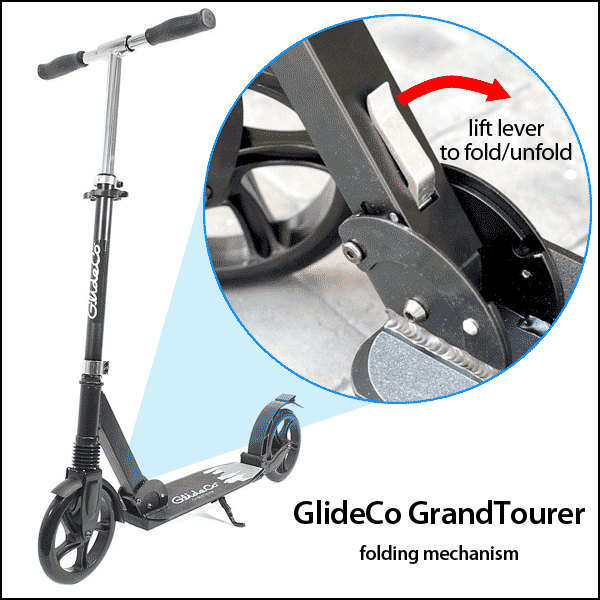
Conclusion
The biggest impact the folding mechanism have is on practicality and convenience.
If you are using a kick scooter for the daily commute, it is more important for the kick scooter to be quick and easy to fold. The single-action systems are recommended, because they typically allow you to fold or unfold a kick scooter in about one second.
If the kick scooter is intended for weekend or occasional leisure use, you probably only need to fold or unfold it to put it into a car boot, or when taking it in or out of storage. In such cases, it does not really matter which system it is.
In terms of performance, the folding mechanism has little effect on the performance of a kick scooter. However, a low quality kick scooter generally suffers from more unnecessary looseness or 'play' in the folding mechanism compared to one with a high build quality. This is usually a result of lower precision parts or poor quality control during assembly. The folding joint also tends to be the first place to break in a low quality kick scooter because of the stresses it is subjected to, as well as the moving parts in it.
Handbrakes
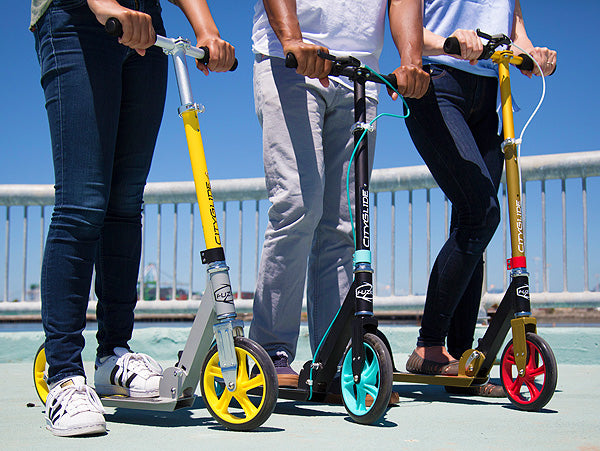
Above: kick scooters with bicycle-style handbrake (first and second from right).
Most kick scooters in the market do not have handbrakes installed. Most scooters are slowed or stopped by stepping down on the rear fender, which doubles as a friction brake on the rear wheel. The rear fender brake is a simple and effective system.
Below: a typical kick scooter rear fender friction brake

Advantages (of handbrake)
- a familiar braking system that everyone can use
- can brake with a shorter reaction time compared to the kick scooter friction brake
Disadvantages
- only available on a limited number of brands and models of kick scooters. It may limit your purchase options.
- adds weight and complexity to your kick scooter
Conclusion
Bicycle-style handbrakes are nice to have, but are generally considered non-essential on kick scooters. It takes only a very short time to get accustomed to using the standard rear fender friction brake. Insist on it only if you really face difficulty using the fender brake.
Overall Build Quality
Technical specifications aside, the overall quality of a kick scooter has a big impact on all the performance and ride quality of a kick scooter.
Because well-known brands have a reputation to keep, so they tend to ensure their kick scooters are well-made and durable. Unbranded kick scooters or shopping mall sports department house brands tend to attract using low prices and so quality is not a priority.
These are some common problems on scooters with low build quality:
- parts don't fit tightly together, giving the scooter a flimsy feel. In particular, unnecessary movement in parts like the folding joint, collapsible handlebar grips, telescopic steering column etc
- rattling sound or squeaks when riding
- low-quality bearings, kick scooter rolls only a very short distance with every push
- parts with screw threads tend to drop off or require frequent tightening
- paint chip off easily, raw aluminum tarnishes with use
- overly heavy in weight because of substitution of aluminum parts with steel
Conclusion
For an enjoyable leisure ride in the weekend, or if you need to use the scooter on a daily basis, be prepared to spend a little bit more for the ride quality and durabilty.
The Final Word

What kind of scooter is best for you depends on the context of your use. Among the 3 key purchase consideration of convenience, performance and comfort, it is most likely you can satisfy only two and have to compromise on one. So you have to decide what is most important to you.
If convenience is the priority - for example, if you use the kick scooter for the daily commute - favour light-weight and portable kick scooters with high build-quality and small wheels. This is particularly important if your riding journey is short and if you have to carry the scooter onto public transportation.
If ride comfort and enjoyment is the priority, go for a kick scooter with a large and low deck, large wheels and possibly with suspension.
If performance and speed are important, choose a kick scooter with large wheels, low deck, light overall weight and high-quality bearings, preferably with no suspension.
Across all three considerations, try to get as high a build quality as your budget allows. Remember you get what you pay for. If possible, test ride a kick scooter before you buy it.
If test riding is not possible - for example if you are making an online purchase - it will always be a better bet to choose a well known international brand. If possible, purchase from the appointed local distributor, or an authorized dealer who can extend warranty coverage for the product.
And finally, accept that the scooter you choose doesn't have to be your only one. Many riders only discover their favourite kick scooters after owning a few different ones. Do your homework, then trust your judgement and go for it! After all, it is supposed to be fun! []
You are welcome to make references to this article, as long as you post a hyperlink and attribute it to "Decks And Scooters". You are also welcome to hyperlink directly to this article.

